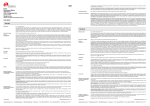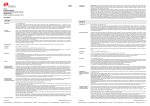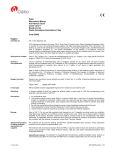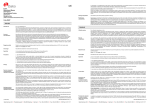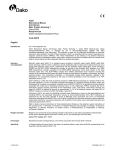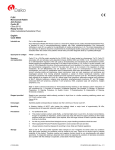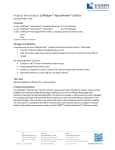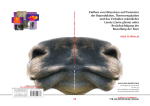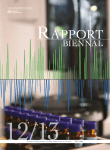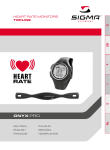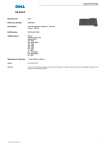Download FLEX Monoclonal Mouse Anti-Human Neuron-Specific
Transcript
evaluating pathologist should desire a different staining intensity, a Dako Application Specialist/Technical Service Specialist can be contacted for information on re-programming of the protocol. Verify that the performance of the adjusted protocol is still valid by evaluating that the staining pattern is identical to the staining pattern described in “Performance characteristics”. FLEX Monoclonal Mouse Anti-Human Neuron-Specific Enolase Clone BBS/NC/VI-H14 Ready-to-Use (Dako Autostainer/Autostainer Plus) Counterstaining in hematoxylin is recommended using EnVision FLEX Hematoxylin, (Dako Autostainer/Autostainer Plus) (Code K8018). Non-aqueous, permanent mounting medium is recommended. Positive and negative controls should be run simultaneously using the same protocol as the patient specimens. The positive control tissue should include colon and the cells/structures should display reaction patterns as described for this tissue in “Performance characteristics” in all positive specimens. The recommended negative control reagent is FLEX Negative Control, Mouse, (Dako Autostainer/Autostainer Plus) (Code IS750). Staining interpretation Cells labeled by the antibody display cytoplasmic and nuclear staining. In neurons, labeling occurs in both cytoplasm and processes. Performance characteristics Normal tissues: The antibody labels neurons in human cerebral cortex and brainstem nuclei (1). Additionally, the antibody labels ganglion cells in the human gastrointestinal tract and myelinated and unmyelinated nerve fibers (1). In normal adult testis, the antibody displays weak immunostaining of the spermatogonia (3). In colon, the ganglion cells of the Auerbach’s plexus show a moderate to strong cytoplasmic and nuclear staining reaction, whereas the isolated axons in the muscularis externa show a weak to moderate cytoplasmic staining reaction. Abnormal tissues: The antibody labeled tumors derived from or containing neurons, ganglion cells and peripheral nerves. However, also nonneuronal derived tumors, as meningiomas, medulloblastomas, astrocytomas, glioblastomas, oligoastrocytomas, oligodendrogliomas, pituitary adenomas, schwannomas, ependymomas, meningosarcomas, gliosarcomas and metastases of different origin – i.e. melanomas, small- cell carcinomas of lung, and undifferentiated carcinomas may be labeled specifically (1, 4). In addition, the antibody labeled germ cell tumors, i.e. testicular carcinomas-in-situ, seminomas and embryonal carcinomas (3). Code IS612 ENGLISH Intended use For in vitro diagnostic use. FLEX Monoclonal Mouse Anti-Human Neuron-Specific Enolase, Clone BBS/NC/VI-H14, Ready-to-Use, (Dako Autostainer/Autostainer Plus), is intended for use in immunohistochemistry together with Dako Autostainer/Autostainer Plus instruments. This antibody labels both normal and neoplastic cells of neuronal and neuroendocrine origin (1), and although neuron-specific enolase (NSE) is not an exclusive neuronal marker, it may be used for the identification of peripheral nerves, neural and neuroendocrine tumors, such as neuroblastomas, retinoblastomas, desmoplastic malignant melanoma and small-cell lung cancer (2, 3). The clinical interpretation of any staining or its absence should be complemented by morphological studies using proper controls and should be evaluated within the context of the patient's clinical history and other diagnostic tests by a qualified pathologist. Synonyms for antigen γ-enolase and 14-3-2 protein (4). Summary and explanation Enolases (2-phospho-D-glycerate hydrolase) are glycolytic homo- or heterodimeric isoenzymes, which catalyse the interconversion of 2phosphoglycerate and phosphoenolpyruvate. Three subunits, α (46 kDa), β (44 kDa) and γ (46 kDa), constitute the building blocks of the enolase molecules, and five forms (αα, ββ, γγ, αβ and αγ) of the enzyme have been identified (5). The enolases are divided in three main groups according to their localization: non-neuronal enolase (NNE or α), muscle-specific enolase (MSE or β), and neuron-specific enolase (NSE or γ) (3). Refer to Dako’s General Instructions for Immunohistochemical Staining or the detection system instructions of IHC procedures for: 1) Principle of Procedure, 2) Materials Required, Not Supplied, 3) Storage, 4) Specimen Preparation, 5) Staining Procedure, 6) Quality Control, 7) Troubleshooting, 8) Interpretation of Staining, 9) General Limitations. Reagent provided Ready-to-use monoclonal mouse antibody provided in liquid form in a buffer containing stabilizing protein and 0.015 mol/L sodium azide. Clone: BBS/NC/VI-H14 (1). Isotype: IgG1, kappa. Immunogen γγ-enolase purified from human brain by a dissociation-reassociation method in a chromatofocusing column (1). Specificity In Western blotting of reduced, SDS-denatured purified human γγ-enolase, αα-enolase, and extract of human muscle containing ββ-enolase, the antibody labels solely the γ-enolase subunit (1). As demonstrated by immunohistochemistry on formalin-fixed, paraffin-embedded tissue sections, the antibody cross-reacts with the NSEequivalent protein in pig (1). Precautions 1. For professional users. 2. This product contains sodium azide (NaN3), a chemical highly toxic in pure form. At product concentrations, though not classified as hazardous, sodium azide may react with lead and copper plumbing to form highly explosive build-ups of metal azides. Upon disposal, flush with large volumes of water to prevent metal azide build-up in plumbing. 3. As with any product derived from biological sources, proper handling procedures should be used. 4. Wear appropriate Personal Protective Equipment to avoid contact with eyes and skin. 5. Unused solution should be disposed of according to local, State and Federal regulations. Storage Store at 2-8 °C. Do not use after expiration date sta mped on vial. If reagents are stored under any conditions other than those specified, the conditions must be verified by the user. There are no obvious signs to indicate instability of this product. Therefore, positive and negative controls should be run simultaneously with patient specimens. If unexpected staining is observed which cannot be explained by variations in laboratory procedures and a problem with the antibody is suspected, contact Dako Technical Support. Specimen preparation including materials required but not supplied The antibody can be used for labeling formalin-fixed, paraffin-embedded tissue sections. Tissue specimens should be cut into sections of approximately 4 µm. Pre-treatment with heat-induced epitope retrieval (HIER) is required using Dako PT Link (Code PT100/PT101). For details, please refer to the PT Link User Guide. Optimal results are obtained by pretreating tissues using EnVision FLEX Target Retrieval Solution, High pH (50x) (Code K8010/K8004). Paraffin-embedded sections: Pre-treatment of formalin-fixed, paraffin-embedded tissue sections is recommended using the 3-in-1 specimen preparation procedure for Dako PT Link. Follow the pre-treatment procedure outlined in the package insert for EnVision FLEX Target Retrieval Solution, High pH (50x) (Code K8010/K8004). Note: After staining the sections must be dehydrated, cleared and mounted using permanent mounting medium. Deparaffinized sections: Pre-treatment of deparaffinized formalin-fixed, paraffin-embedded tissue sections is recommended using Dako PT Link and following the same procedure as described for paraffin-embedded sections. After staining the slides should be mounted using aqueous or permanent mounting medium. The tissue sections should not dry out during the treatment or during the following immunohistochemical staining procedure. For greater adherence of tissue sections to glass slides, the use of FLEX IHC Microscope Slides (Code K8020) is recommended. Staining procedure including materials required but not supplied FRANÇAIS Utilisation prévue Pour utilisation diagnostique in vitro. FLEX Monoclonal Mouse Anti-Human Neuron-Specific Enolase, Clone BBS/NC/VI-H14, Ready-to-Use, (Dako Autostainer/Autostainer Plus) est destiné à une utilisation en immunohistochimie avec les instruments Dako Autostainer/Autostainer Plus. L’anticorps marque les cellules normales et néoplasiques d‘origine neuronale et neuroendocrine (1), et bien que l’énolase neurone-spécifique (NSE) ne soit pas un marqueur neuronal exclusif, elle peut être utilisée pour l’identification des nerfs périphériques, des tumeurs neurales et neuroendocrines, des neuroblastomes, des rétinoblastomes, du mélanome malin desmoplastique ainsi que du cancer des poumons à petites cellules (2,3). L’interprétation clinique de toute coloration ou son absence doit être complétée par des études morphologiques en utilisant des contrôles appropriés et doit être évaluée en fonction des antécédents cliniques du patient et d’autres tests diagnostiques par un pathologiste qualifié. Synonymes de l’antigène γ-énolase et protéine 14-3-2 (4). Résumé et explication Les énolases (2-phospho-D-glycérate hydrolases) sont des isoenzymes glycolytiques homo- ou hétéro- dimériques qui catalysent l’interconversion du phosphoglycérate et du phosphoénolpyruvate. Trois sous-unités, α (46 kDa), β (44 kDa) et γ (46 kDa), constituent des composantes des molécules d’énolases et, cinq formes de l’enzyme (αα, ββ, γγ, αβ et αγ) ont été identifiées (5). Les énolases sont divisées en trois groupes principaux en fonction de leur localisation : l’énolase non neuronale (NNE ou α), l’énolase muscle spécifique (MSE ou β), et l’énolase neurone spécifique (NSE ou γ) (3). Se référer aux Instructions générales de coloration immunohistochimique de Dako ou aux instructions du système de détection relatives aux procédures IHC pour plus d’informations concernant les points suivants : 1) Principe de procédure, 2) Matériels requis mais non fournis, 3) Conservation, 4) Préparation des échantillons, 5) Procédure de coloration, 6) Contrôle qualité, 7) Dépannage, 8) Interprétation de la coloration, 9) Limites générales. Réactifs fournis Anticorps monoclonal de souris prêt à l’emploi fourni sous forme liquide dans un tampon contenant une protéine stabilisante et 0,015 mol/L d’azide de sodium. Clone : BBS/NC/VI-H14 (1). Isotype : IgG1, kappa. Immunogène γγ-énolase purifiée à partir de cerveau humain par une méthode de dissociation-réassociation par chromatofocusing sur colonne (1). Spécificité Lors d’un Western blot de γγ-énolase, et αα-énolase réduites, purifiées et dénaturées au SDS et d’un extrait de muscle humain contenant de la ββ-énolase, seule la sous-unité γ-énolase est marquée par l’anticorps (1). Comme le démontre l’analyse immunohistochimique de tissus fixés au formol et inclus en paraffine, l’anticorps présente une réaction croisée avec la protéine homologue de la NSE chez le porc (1). Précautions 1. Pour utilisateurs professionnels. 2. Ce produit contient de l’azide de sodium (NaN3), produit chimique hautement toxique dans sa forme pure. Aux concentrations du produit, bien que non classé comme dangereux, l’azide de sodium peut réagir avec le cuivre et le plomb des canalisations et former des accumulations d’azides métalliques hautement explosives. Lors de l’élimination, rincer abondamment à l’eau pour éviter toute accumulation d’azide métallique dans les canalisations. 3. Comme avec tout produit d’origine biologique, des procédures de manipulation appropriées doivent être respectées. 4. Porter un vêtement de protection approprié pour éviter le contact avec les yeux et la peau. 5. Les solutions non utilisées doivent être éliminées conformément aux réglementations locales et nationales. Conservation Conserver entre 2 et 8 °C. Ne pas utiliser après la date de péremption indiquée sur le flacon. Si les réactifs sont conservés dans des conditions autres que celles indiquées, celles-ci doivent être validées par l’utilisateur. Il n’y a aucun signe évident indiquant l’instabilité de ce produit. Par conséquent, des contrôles positifs et négatifs doivent être testés en même temps que les échantillons de patient. Si une coloration inattendue est observée, qui ne peut être expliquée par un changement des procédures du laboratoire, et en cas de suspicion d’un problème lié à l’anticorps, contacter l’assistance technique de Dako. Préparation des échantillons y compris le matériel requis mais non fourni L’anticorps peut être utilisé pour le marquage des coupes de tissus inclus en paraffine et fixés au formol. L’épaisseur des coupes d’échantillons de tissu doit être d’environ 4 µm. Un prétraitement avec démasquage d’épitope induit par la chaleur (HIER) est nécessaire avec le Dako PT Link (Réf. PT100/PT101). Pour plus de détails, se référer au Guide d’utilisation du PT Link. Des résultats optimaux sont obtenus en prétraitant les tissus à l’aide de la EnVision FLEX Target Retrieval Solution, High pH (50x) (Réf. K8010/K8004). Coupes incluses en paraffine : le prétraitement des coupes tissulaires fixées au formol et incluses en paraffine est recommandé à l'aide de la procédure de préparation d'échantillon 3-en-un pour le Dako PT Link. Suivre la procédure de prétraitement indiquée dans la notice de la EnVision FLEX Target Retrieval Solution, High pH (50x) (Réf. K8010/K8004). Remarque : après coloration, les coupes doivent être déshydratées, lavées et montées à l’aide d’un milieu de montage permanent. Coupes déparaffinées : le prétraitement des coupes tissulaires déparaffinées, fixées au formol et incluses en paraffine, est recommandé à l’aide du Dako PT Link, en suivant la même procédure que pour les coupes incluses en paraffine. Après coloration, un montage aqueux ou permanent des lames est recommandé. Les coupes de tissus ne doivent pas sécher lors du traitement ni lors de la procédure de coloration immunohistochimique suivante. Pour une meilleure adhérence des coupes de tissus sur les lames de verre, il est recommandé d’utiliser des lames FLEX IHC Microscope Slides (Réf. K8020). The recommended visualization system is EnVision FLEX, High pH, (Dako Autostainer/Autostainer Plus) (Code K8010). The staining steps and incubation times are pre-programmed into the software of Dako Autostainer/Autostainer Plus instruments, using the following protocols: Template protocol: FLEXRTU2 (200 µL dispense volume) or FLEXRTU3 (300 µL dispense volume) Autoprogram:NSE (without counterstaining) or NSEH (with counterstaining) The Auxiliary step should be set to “rinse buffer” in staining runs with ≤10 slides. For staining runs with >10 slides the Auxiliary step should be set to “none”. This ascertains comparable wash times. All incubation steps should be performed at room temperature. For details, please refer to the Operator’s Manual for the dedicated instrument. If the protocols are not available on the used Dako Autostainer instrument, please contact Dako Technical Services. Optimal conditions may vary depending on specimen and preparation methods, and should be determined by each individual laboratory. If the (115239-002) Dako Denmark A/S IS612/EFG/MNI/2009.12.04 p. 1/4 | Produktionsvej 42 | DK-2600 Glostrup | Denmark | Tel. +45 44 85 95 00 | Fax +45 44 85 95 95 | CVR No. 33 21 13 17 (115239-002) Dako Denmark A/S IS612/EFG/MNI/2009.12.04 p. 2/4 | Produktionsvej 42 | DK-2600 Glostrup | Denmark | Tel. +45 44 85 95 00 | Fax +45 44 85 95 95 | CVR No. 33 21 13 17 Procédure de coloration y compris le matériel requis mais non fourni Le système de visualisation recommandé est le EnVision FLEX, High pH, (Dako Autostainer/Autostainer Plus) (Réf. K8010). Les étapes de coloration et d’incubation sont préprogrammées dans le logiciel des instruments Dako Autostainer/Autostainer Plus, à l’aide des protocoles suivants : Protocole modèle : FLEXRTU2 (volume de distribution de 200 µL) ou FLEXRTU3 (volume de distribution de 300 µL) Autoprogram : NSE (sans contre-coloration) ou NSEH (avec contre-coloration). Vorbereitung der Probe und erforderliche, aber nicht mitgelieferte Materialien Der Antikörper eignet sich zur Markierung von formalinfixierten und paraffineingebetteten Gewebeschnitten. Gewebeproben sollten in Schnitte von ca. 4 µm Stärke geschnitten werden. Die Vorbehandlung durch hitzeinduzierte Epitopdemaskierung (HIER) mit Dako PT Link (Code-Nr. PT100/PT101) ist erforderlich. Weitere Informationen hierzu siehe PT Link-Benutzerhandbuch. Optimale Ergebnisse können durch Vorbehandlung der Gewebe mit EnVision FLEX Target Retrieval Solution, High pH (50x) (Code-Nr. K8010/K8004) erzielt werden. Paraffineingebettete Schnitte: Die Vorbehandlung der formalinfixierten, paraffineingebetteten Schnitte mit dem 3-in-1Probenvorbereitungsverfahren für Dako PT Link wird empfohlen. Vorbehandlung gemäß der Beschreibung in der Packungsbeilage für EnVision FLEX Target Retrieval Solution, High pH (50x) (Code-Nr. K8010/K8004) durchführen. Hinweis: Nach dem Färben müssen die Schnitte dehydriert, geklärt und mit permanentem Einbettmedium auf den Objektträger aufgebracht werden. Entparaffinierte Schnitte: Eine Vorbehandlung der entparaffinierten, formalinfixierten, paraffineingebetteten Gewebeschnitte mit Dako PT Link nach demselben Verfahren, wie für die paraffineingebetteten Schnitte beschrieben, wird empfohlen. Die Objektträger nach dem Färben mit einem wässrigen oder permanenten Einbettmedium bedecken. Die Gewebeschnitte dürfen während der Behandlung oder des anschließenden immunhistochemischen Färbeverfahrens nicht austrocknen. Zur besseren Haftung der Gewebeschnitte an den Glasobjektträgern wird die Verwendung von FLEX IHC Microscope Slides (Code-Nr. K8020) empfohlen. Färbeverfahren und erforderliche, aber nicht mitgelieferte Materialien Das empfohlene Visualisierungssystem ist EnVision™ FLEX, High pH (Dako Autostainer/Autostainer Plus) (Code-Nr. K8010). Die Färbeschritte und Inkubationszeiten sind in der Software der Dako Autostainer/Autostainer Plus-Geräte mit den folgenden Protokollen vorprogrammiert: Matrix-Protokoll: FLEXRTU2 (200 µL Abgabevolumen) oder FLEXRTU3 (300 µL Abgabevolumen) Autoprogram: NSE (ohne Gegenfärbung) oder NSEH (mit Gegenfärbung) Bei Färbedurchläufen mit höchstens 10 Objektträgern sollte der „Zusatz“-Schritt auf „Pufferspülgang“ eingestellt werden. Für Färbedurchläufe mit mehr als 10 Objektträgern den „Zusatz“-Schritt auf „Keine“ einstellen. Dieses gewährleistet vergleichbare Waschzeiten. Alle Inkubationsschritte sollten bei Raumtemperatur durchgeführt werden. Nähere Einzelheiten bitte dem Benutzerhandbuch für das jeweilige Gerät entnehmen. Wenn die Färbeprotokolle auf dem verwendeten Dako Autostainer-Gerät nicht verfügbar sind, bitte den Technischen Kundendienst von Dako verständigen. Optimale Bedingungen können je nach Probe und Präparationsverfahren unterschiedlich sein und sollten vom jeweiligen Labor selbst ermittelt werden. Falls der beurteilende Pathologe eine andere Färbungsintensität wünscht, kann ein Anwendungsspezialist oder Kundendiensttechniker von Dako bei der Neuprogrammierung des Protokolls helfen. Die Leistung des angepassten Protokolls muss verifiziert werden, indem gewährleistet wird, dass das Färbemuster mit dem unter „Leistungsmerkmale“ beschriebenen Färbemuster identisch ist. Die Gegenfärbung in Hämatoxylin sollte mit EnVision™ FLEX Hematoxylin, (Dako Autostainer/Autostainer Plus) (Code-Nr. K8018) ausgeführt werden. Empfohlen wird ein nichtwässriges, permanentes Fixiermittel. Positiv- und Negativkontrollen sollten zur gleichen Zeit und mit demselben Protokoll wie die Patientenproben getestet werden. Das positive Kontrollgewebe muss Dickdarmzellen enthalten, und die Zellen/Strukturen müssen in allen positiven Proben die für dieses Gewebe unter „Leistungsmerkmale“ beschriebenen Reaktionsmuster aufweisen. Das empfohlene Negativ-Kontrollreagenz ist FLEX Negative Control, Mouse, (Dako Autostainer/Autostainer Plus) (Code-Nr. IS750). Auswertung der Färbung Mit diesem Antikörper markierte Zellen weisen ein zytoplasmatisches und nukleäres Färbemuster auf. Bei Neuronen tritt sowohl im Zytoplasma als auch bei den Fortsätzen eine Markierung ein. Leistungsmerkmale Gesundes Gewebe: Der Antikörper markiert Neuronen in der menschlichen Großhirnrinde und Hirnstammkernen (1). Außerdem markiert der Antikörper Ganglienzellen im menschlichen Magen-Darm-Trakt und myelinisierte und unmyelinisierte Nervenfasern (1). Bei normalen adulten Hoden weist der Antikörper eine schwache Immunfärbung der Spermatogonien auf (3). Im Darm zeigen die Ganglionzellen des Plexus Auerbach eine mäßige bis starke zytoplasmatische und nukleäre Färbereaktion, während die isolierten Axone in der Muscularis externa eine schwache bis mäßige zytoplasmatische Färbereaktion aufweisen. Pathologisches Gewebe: Der Antikörper markiert Tumore, die Neuronen, Ganglienzellen oder peripheren Nerven entstammen oder diese enthalten. Es können aber auch nicht-neuronale Tumore, wie z.B. Meningiome, Medulloblastome, Astrozytome, Glioblastome, Oligoastrozytome, Oligodendrogliome, Hypophysenadenome, Schwannome, Ependymome, Meningosarkome, Gliosarkome und Metastasen unterschiedlichen Ursprungs, wie z.B. Melanome, kleinzellige Lungenkarzinome und undifferenzierte Karzinome, spezifisch markiert werden (1, 4). Außerdem markiert der Antikörper Keimzellentumore, also Hoden-Oberflächenkarzinome, Seminome und embryonale Karzinome (3). L’étape Auxiliary doit être réglée sur « rinse buffer » lors des cycles de coloration avec ≤10 lames. Pour les cycles de coloration de >10 lames, l’étape Auxiliary doit être réglée sur « none ». Cela garantit des temps de lavage comparables. Toutes les étapes d’incubation doivent être effectuées à température ambiante. Pour plus de détails, se référer au Manuel de l’opérateur spécifique à l'instrument. If the protocols are not available on the used Dako Autostainer instrument, please contact Dako Technical Services. Les conditions optimales peuvent varier en fonction du prélèvement et des méthodes de préparation, et doivent être déterminées par chaque laboratoire individuellement. Si le pathologiste qui réalise l’évaluation désire une intensité de coloration différente, un spécialiste d’application/spécialiste du service technique de Dako peut être contacté pour obtenir des informations sur la re-programmation du protocole. Vérifier que l'exécution du protocole modifié est toujours valide en vérifiant que le schéma de coloration est identique au schéma de coloration décrit dans les « Caractéristiques de performance ». Il est recommandé d’effectuer une contre-coloration à l’aide de Envision FLEX Hematoxylin, (Dako Autostainer/Autostainer Plus) (Réf. K8018). L’utilisation d’un milieu de montage permanent non aqueux est recommandée. Des contrôles positifs et négatifs doivent être réalisés en même temps et avec le même protocole que les échantillons du patient. Le contrôle de tissu positif doit comprendre le côlon et les cellules/structures doivent présenter des schémas de réaction tels que décrits pour ces tissus dans les « Caractéristiques de performance » pour tous les échantillons positifs. Le contrôle négatif recommandé est le FLEX Negative Control, Mouse, (Dako Autostainer/Autostainer Plus) (Réf. IS750). Interprétation de la coloration Les cellules marquées par l’anticorps présentent une coloration cytoplasmique et nucléaire. Dans les neurones, un marquage est présent dans le cytoplasme et les prolongements. Caractéristiques de performance Tissus sains : L’anticorps marque les neurones dans le cortex cérébral humain et les noyaux du tronc cérébral (1). De plus, l’anticorps marque les cellules ganglionnaires du tractus gastro-intestinal humain et les fibres nerveuses myélinisées et amyéliniques (1). Dans les testicules adultes sains, l’anticorps entraîne une coloration faible des spermatogonies (3). Dans le côlon, les cellules ganglionnaires et le plexus d’Auerbach présentent une coloration cytoplasmique et nucléaire modérée à forte, tandis que la coloration cytoplasmique des axones isolés de la couche musculaire externe est faible à modérée. Tissus tumoraux : L’anticorps marque les tumeurs dérivées de, ou contenant des neurones, des cellules ganglionnaires et des nerfs périphériques. Cependant, des tumeurs non neuronales, telles que les méningiomes, les médulloblastomes, les astrocytomes, les glioblastomes, les oligoastrocytomes, les oligodendrogliomes, les adénomes hypophysaires, les schwannomes, les épendymomes, les méningosarcomes, les gliosarcomes et les métastases de différentes origines, par exemple les mélanomes, les carcinomes pulmonaires à petites cellules, et les carcinomes indifférenciés, peuvent être marqués spécifiquement (1,4). De plus, l’anticorps marque les tumeurs des cellules germinales, par exemple les carcinomes in situ testiculaires, les séminomes et les carcinomes embryonnaires (3). DEUTSCH Zweckbestimmung Zur In-vitro-Diagnostik. FLEX Monoclonal Mouse Anti-Human Neuron-Specific Enolase, Clone BBS/NC/VI-H14, Ready-to-Use, (Dako Autostainer/Autostainer Plus) ist zur Verwendung in der Immunhistochemie in Verbindung mit Dako Autostainer/Autostainer Plus-Geräten bestimmt. Dieser Antikörper markiert sowohl gesunde als auch neoplastische Zellen neuronalen und neuroendokrinen Ursprungs (1), und obwohl neuronenspezifische Enolase (NSE) kein exklusiver neuronaler Marker ist, eignet er sich zur Identifizierung von peripheren Nerven, neuralen und neuroendokrinen Tumoren, Neuroblastomen, Retinoblastomen, desmoplastischen malignen Melanomen sowie kleinzelligem Lungenkrebs (2, 3). Die klinische Auswertung einer eventuell eintretenden Färbung sollte durch morphologische Studien mit ordnungsgemäßen Kontrollen ergänzt werden und von einem qualifizierten Pathologen unter Berücksichtigung der Krankengeschichte und anderer Diagnostiktests des Patienten vorgenommen werden. Synonyme für das Antigen γ-Enolase und 14-3-2-Protein (4). Zusammenfassung und Erklärung Enolasen (2-Phospho-D-Glycerathydrolase) sind glykolytische homo- oder heterodimere Isoenzyme, die die wechselseitige Umwandlung von 2-Phosphoglycerat und Phosphoenolpyruvat katalysieren. Drei Untereinheiten namens α (46 kDa), β (44 kDa) und γ (46 kDa) bilden die Bausteine der Enolasemoleküle, und fünf Formen (αα, ββ, γγ, αβ und αγ) des Enzyms wurden bisher identifiziert (5). Die Enolasen werden in Abhängigkeit von ihrer Lokalisierung in drei Hauptgruppen eingeteilt: nicht-neuronale Enolase (NNE oder α), muskelspezifische Enolase (MSE oder β) und neuronenspezifische Enolase (NSE oder γ) (3). Folgende Angaben bitte den Allgemeinen Richtlinien zur immunhistochemischen Färbung von Dako oder den Anweisungen des Detektionssystems für IHC-Verfahren entnehmen: 1) Verfahrensprinzip, 2) Erforderliche, aber nicht mitgelieferte Materialien, 3) Aufbewahrung, 4) Vorbereitung der Probe, 5) Färbeverfahren, 6) Qualitätskontrolle, 7) Fehlersuche und -behebung, 8) Auswertung der Färbung, 9) Allgemeine Beschränkungen. Geliefertes Reagenz Gebrauchsfertiger, monoklonaler Maus-Antikörper in flüssiger Form in einem Puffer, der stabilisierendes Protein und 0,015 mol/L Natriumazid enthält. Klon: BBS/NC/VI-H14 (1). Isotyp: IgG1, Kappa. Immunogen Aus dem menschlichen Gehirn mittels Dissoziation und anschließender Reassoziation in einer Chromatofocusing-Säule gereinigte γγ-Enolase (1). Spezifität Vorsichtsmaßnahmen Lagerung (115239-002) Dako Denmark A/S References/ Références/ Literatur 1. 2. 3. Soler Federsppiel BS, Cras P, Gheuens J, Andries D, Lowenthal A. Human γγ-enolase: two-site immuno-radiometric assay with a single monoclonal antibody. J Neurochem 1987; 48:22-8. Anstey A, Cerio R, Ramnarain N, Orchard G, Smith N, Jones EW. Desmoplastic malignant melanoma. An immunocytochemical study of 25 cases. Am J Dermatopathol 1994; 16:14-22. Kang J-L, Meyts ER, Skakkebæk NE. Immunoreactive neuron-specific enolase (NSE) is expressed in testicular carcinoma-in-situ. J Pathol 1996; 178:161-5. 4. Cras P, Martin JJ, Gheuens J. γ-enolase and glial fibrillary acidic protein in nervous system tumors. An immunohistochemical study using specific monoclonal antibodies. Acta Neuropathol 1988; 75:377-84. 5. Shimizu A, Suzuki F, Kato K. Characterization of αα, ββ, γγ and αγ human enolase isoenzymes, and preparation of hybrid enolases (αγ, βγ and αβ) from homodimeric forms. Biochim Biophys Acta 1983; 748:278-84. Explanation of symbols/ Explication des symboles/ Erläuterung der Symbole Beim Western-Blotting von reduzierter, SDS-denaturierter gereinigter menschlicher γγ-Enolase, αα-Enolase und menschlichem Muskelextrakt mit ββ-Enolase markiert der Antikörper ausschließlich die γ-Enolase-Untereinheit (1). Durch immunhistochemische Untersuchungen an formalinfixierten, paraffineingebetteten Gewebeschnitten wurde eine Kreuzreaktivität dieses Antikörpers mit dem NSE-äquivalenten Protein vom Schwein nachgewiesen (1). 1. Nur für Fachpersonal bestimmt. 2. Dieses Produkt enthält Natriumazid (NaN3), eine in reiner Form äußerst giftige Chemikalie. Natriumazid kann auch in als ungefährlich eingestuften Konzentrationen mit Blei- und Kupferrohren reagieren und hochexplosive Metallazide bilden. Nach der Entsorgung stets mit viel Wasser nachspülen, um Metallazidansammlungen in den Leitungen vorzubeugen. 3. Wie alle Produkte biologischen Ursprungs müssen auch diese entsprechend gehandhabt werden. 4. Geeignete Schutzkleidung tragen, um Augen- und Hautkontakt zu vermeiden. 5. Nicht verwendete Lösung ist entsprechend örtlichen, bundesstaatlichen und staatlichen Richtlinien zu entsorgen. Catalogue number Référence catalogue Bestellnummer Temperature limitation Limites de température Use by Utiliser avant Zulässiger Temperaturbereich Verwendbar bis In vitro diagnostic medical device Dispositif médical de diagnostic in vitro In-vitro-Diagnostikum Contains sufficient for <n> tests Contenu suffisant pour <n> tests Manufacturer Fabricant Inhalt ausreichend für <n> Tests Hersteller Consult instructions for use Voir les instructions d’utilisation Gebrauchsanweisung beachten Batch code Numéro de lot Chargenbezeichnung Bei 2–8 °C aufbewahren. Nach Ablauf des auf dem Fläschch en aufgedruckten Verfalldatums nicht mehr verwenden. Werden die Reagenzien unter anderen als den angegebenen Bedingungen aufbewahrt, müssen diese Bedingungen vom Benutzer validiert werden. Es gibt keine offensichtlichen Anzeichen für eine eventuelle Produktinstabilität. Positiv- und Negativkontrollen sollten daher zur gleichen Zeit wie die Patientenproben getestet werden. Falls es zu einer unerwarteten Färbung kommt, die sich nicht durch Unterschiede bei Laborverfahren erklären lässt und auf ein Problem mit dem Antikörper hindeutet, ist der technische Kundendienst von Dako zu verständigen. IS612/EFG/MNI/2009.12.04 p. 3/4 | Produktionsvej 42 | DK-2600 Glostrup | Denmark | Tel. +45 44 85 95 00 | Fax +45 44 85 95 95 | CVR No. 33 21 13 17 (115239-002) Dako Denmark A/S IS612/EFG/MNI/2009.12.04 p. 4/4 | Produktionsvej 42 | DK-2600 Glostrup | Denmark | Tel. +45 44 85 95 00 | Fax +45 44 85 95 95 | CVR No. 33 21 13 17



